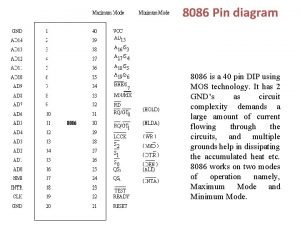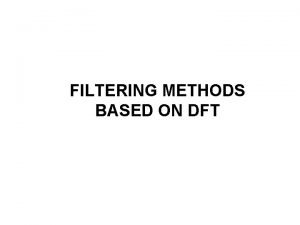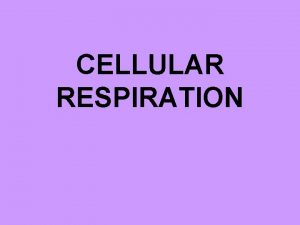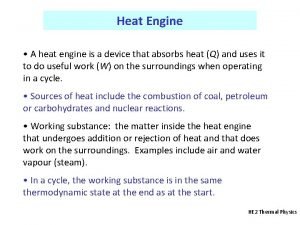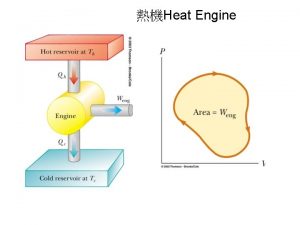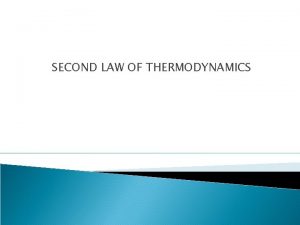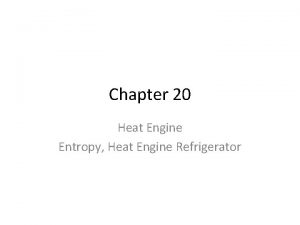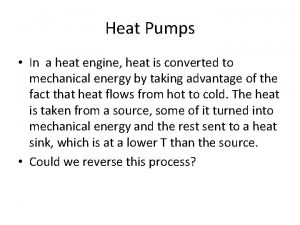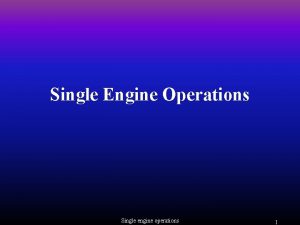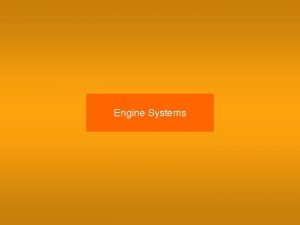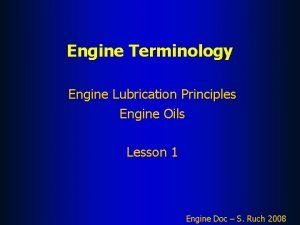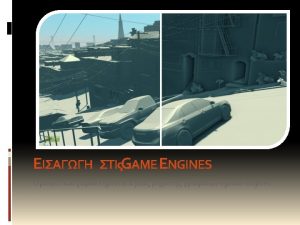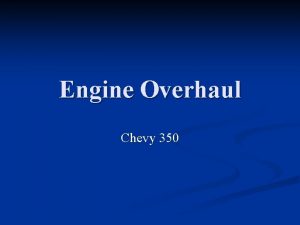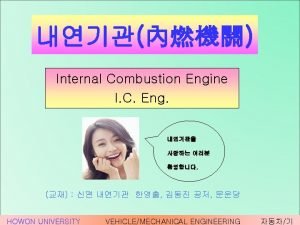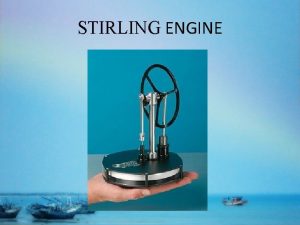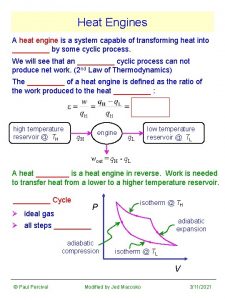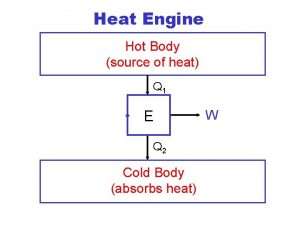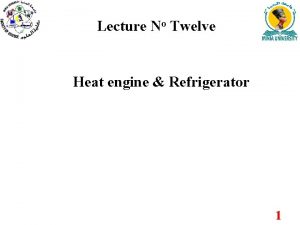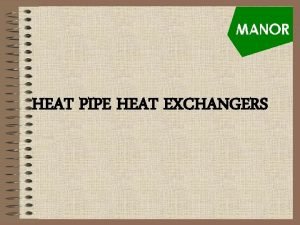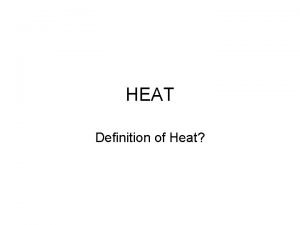2 Heat engine A heat engine performs the







































- Slides: 39

2. Heat engine A heat engine performs the conversion of heat energy to mechanical work. Heat engines typically run on a specific thermodynamic cycle.

An internal combustion engine is an engine in which the combustion of a fuel occurs in a combustion chamber inside the engine. In an internal combustion engine it is always the expansion of the high temperature and pressure gases that are produced by the combustion which apply force to the movable component of the engine, such as the pistons or turbine blades. The internal combustion engine contrasts with the external combustion engine, such as a steam engine in which the energy is delivered within a working fluid heated in a boiler by fossil fuel, wood-burning, nuclear, solar etc.

Internal combustion engine (ICE) types - Intermittent combustion four-stroke piston engines (gasoline/petrol or diesel) two-stroke piston engines (gasoline /petrol or diesel) - Continuous combustion jet engines (including gas turbines) rockets

Four-stroke engines (Otto cycle) 1. intake stroke 2. compression stroke 3. combustion (power) stroke 4. exhaust stroke

Intake The piston descends from the top of the cylinder, reducing the pressure inside the cylinder. A mixture of fuel and air is forced into the cylinder through the intake port.

Compression The intake valve closes, and the compression stroke compresses the fuel–air mixture.

Power The air–fuel mixture is then ignited near the end of the compression stroke, by a spark plug. The resulting pressure of burning gases pushes the piston through the power stroke.

Exhaust In the exhaust stroke, the piston pushes the products of combustion from the cylinder through an exhaust valve.

Two-stroke engines (Otto cycle) Spark-plug fires once every revolution. Overlap operations in order to reduce the part count.

Intake/Compression. The fuel/air mixture is first drawn into the crankcase by the vacuum created during the upward stroke of the piston. The piston rises, and compresses the fuel mixture.

Power. At the top of the stroke the spark plug ignites the fuel mixture. The burning fuel expands, driving the piston downward.

Transfer/Exhaust. The piston exposes the intake port, allowing the compressed fuel/air mixture in the crankcase to escape around the piston into the main cylinder. This expels the exhaust gases out the exhaust port, usually located on the opposite side of the cylinder. Unfortunately, some of the fresh fuel mixture is usually expelled as well.

Since the two stroke engine fires on every revolution of the crankshaft, a two stroke engine is usually more powerful than a four stroke engine of equivalent size. This, coupled with their lighter, simpler construction, makes two stroke engines popular in • chainsaws, • line trimmers, • outboard motors, • snowmobiles, • jet-skis, • light motorcycles, • model airplanes. Unfortunately most two stroke engines are inefficient and are terrible polluters due to the amount of unspent fuel that escapes through the exhaust port.



Diesel engines Uses the heat of compression to initiate ignition to burn the fuel, which is injected into the combustion chamber during the final stage of compression.

Induction Draw in a new volume of charge air into the cylinder. (turbochargers)

Compression Raise the temperature of the charge air to the point where fuel injected into the cylinder spontaneously ignites. In this cycle, the separation of fuel from the charge air eliminates problems with autoignition and therefore allows Diesel engines to operate at much higher compression ratios than those currently in production with the Otto Cycle.

Compression Ignition Fuel is injected from the high pressure fuel injector and spontaneously ignites in the cylinder.

Power The injected fuel spontaneously ignites with the air, it generates a high pressure which forces the piston down.

Exhaust The gases formed during combustion are ejected from the cylinder.

The linear motion of a piston must be turned into a rotation. This is typically achieved by a crankshaft. A crankshaft for a 4 cylinder engine

Thermodynamics (Otto cycle) Intake stroke, gasoline vapor and air drawn into engine (5 1). Compression stroke, p, T increase (1 2). Combustion (2 3), model: heat absorbed of reservoirs at temperatures T 2 to T 3 Power stroke: expansion (3 4) Valve exhaust: valve opens, gas escapes. Model: rejection of heat to reservoirs at temperatures T 4 to T 1. Exhaust stroke, piston pushes remaining combustion products out of chamber (1 5).


The ideal Otto cycle An actual Otto cycle

Engine efficiency of thermal engines is the relationship between the total energy contained in the fuel, and the amount of energy used to perform useful work. The general expression for thermal efficiency of a cycle: QL is negative. The heat absorbed can be related to the temperature change from state 2 to state 3 as: The heat rejected is given by (perfect gas, constant specific heats)

Substituting, thermal efficiency: We can simplify the above expression using the fact that the processes from 1 to 2 and from 3 to 4 are isentropic: where is the heat capacity ratio: The quantity V 1/V 2 = r is called the compression ratio. In terms of compression ratio, the efficiency of an ideal Otto cycle is:

Ideal Otto cycle thermal efficiency The efficiency depends on the compression ratio.


Modern gasoline engines have an average efficiency of about 25 to 30%. At slow speed the efficiency is much lower than average, and it improves considerably at open road speeds; it peaks in most applications at around 75%. Diesel engines cycle are usually more efficient, since use much higher compression ratios. Most efficient type, direct injection Diesels, are able to reach an efficiency of about 40%.

The efficiency depends on several factors, one of which is the compression ratio. The greater the ratio the more efficient is the machine. Higher ratio engines need gasoline with higher octane value, which inhibits the fuel's tendency to burn nearly instantaneously (known as detonation or knock) at high compression/high heat conditions. Octane rating is the detonation resistance (anti-knock rating) compared to a mixture of iso-octane (2, 2, 4 -trimethylpentane) and n-heptane. By definition, iso-octane is assigned an octane rating of 100 and heptane is assigned an octane rating of zero. An 95 -octane gasoline, for example, possesses the same antiknock rating of a mixture of 95% (by volume) iso-octane and 5% n-heptane.

This does not mean, however, that the gasoline actually contains these hydrocarbons in these proportions. It simply means that it has the same detonation resistance as the described mixture. Because some fuels are more knock-resistant than iso-octane, the definition has been extended to allow for octane numbers higher than 100. For example ethanol has an octane rating of 129.

„Octane booster" petrol additives MTBE (Methyl tert-butyl ether) (pollutes the groundwater, max 5% in EU ) ETBE (Ethyl tert-butyl ether) Isooctane Toluene (tetra-ethyl lead, restricted)

A gasoline motor burns a mix of gasoline and air, consisting of a range of about twelve to eighteen parts (by weight) of air to one part of fuel. A mixture with a 14. 7: 1 air/fuel ratio is said to be stoichiometric, that is when burned, 100% of the fuel and the oxygen are consumed. Mixtures with slightly less fuel, called lean burn are more efficient, whilst slightly rich mixtures, produce more power at the expense of higher fuel consumption. The combustion results in - water vapor, - carbon dioxide, - and sometimes carbon monoxide - and partially-burned hydrocarbons. - In addition, at high temperatures the air's oxygen tends to combine with the air's nitrogen, forming oxides of nitrogen.

Cetane number A measurement of the combustion quality of diesel fuel during compression ignition. A measure of a fuel's ignition delay: the time period between the start of injection and start of combustion of the fuel (how well they ignite under compression). Higher cetane fuels have shorter ignition delay periods than lower cetane fuels. Diesels operate more effectively with higher cetane number fuels. The current standard in the EU is min 46 (premium diesel fuel: 60).

Cetane (hexadecane) ignites very easily under compression, it was assigned a cetane number of 100. While alpha-methyl napthalene was assigned a cetane number of 15 The overall cetane number of the diesel is the average cetane quality of all the components (hundreds). There is very little actual cetane in diesel fuel.

Wankel engine (invented by Felix Wankel) Uses a rotary design instead of reciprocating pistons. Mazda RX-8

Gas turbine A rotary engine that extracts energy from a flow of combustion gas. E. g. aircraft, trains, ships, generators, and even tanks. A 1968 Howmet TX, the only turbine-powered race car to have achieved victory.

Jet engine Discharges a fast moving jet of fluid to generate thrust in accordance with Newton's laws of motion.
 Ethan is observing chemical and physical properties
Ethan is observing chemical and physical properties Input signals in 8086 microprocessor
Input signals in 8086 microprocessor Becker & smith cpas performs
Becker & smith cpas performs A chemist performs the same tests on two
A chemist performs the same tests on two Gaurav 8 bit
Gaurav 8 bit Backend phases of compiler
Backend phases of compiler Elizabeth picks up the clothes from her bedroom floor
Elizabeth picks up the clothes from her bedroom floor Dft performs filtering operation in:
Dft performs filtering operation in: The skin performs all of the following except
The skin performs all of the following except Why did marcus garvey's movement fall apart
Why did marcus garvey's movement fall apart Whom does mercutio curse as he lies dying after a duel?
Whom does mercutio curse as he lies dying after a duel? What type of cell performs cellular respiration
What type of cell performs cellular respiration A subprogram that performs a specific task
A subprogram that performs a specific task A computed is a calculation that a dbms performs
A computed is a calculation that a dbms performs This operator performs integer division.
This operator performs integer division. External vs internal combustion engine
External vs internal combustion engine Tư thế ngồi viết
Tư thế ngồi viết Thế nào là giọng cùng tên? *
Thế nào là giọng cùng tên? * Làm thế nào để 102-1=99
Làm thế nào để 102-1=99 Thể thơ truyền thống
Thể thơ truyền thống Chúa yêu trần thế
Chúa yêu trần thế Sự nuôi và dạy con của hổ
Sự nuôi và dạy con của hổ đại từ thay thế
đại từ thay thế Diễn thế sinh thái là
Diễn thế sinh thái là Vẽ hình chiếu vuông góc của vật thể sau
Vẽ hình chiếu vuông góc của vật thể sau Công thức tính độ biến thiên đông lượng
Công thức tính độ biến thiên đông lượng Thế nào là mạng điện lắp đặt kiểu nổi
Thế nào là mạng điện lắp đặt kiểu nổi Tỉ lệ cơ thể trẻ em
Tỉ lệ cơ thể trẻ em Lời thề hippocrates
Lời thề hippocrates Vẽ hình chiếu đứng bằng cạnh của vật thể
Vẽ hình chiếu đứng bằng cạnh của vật thể Quá trình desamine hóa có thể tạo ra
Quá trình desamine hóa có thể tạo ra Các môn thể thao bắt đầu bằng tiếng đua
Các môn thể thao bắt đầu bằng tiếng đua Hình ảnh bộ gõ cơ thể búng tay
Hình ảnh bộ gõ cơ thể búng tay Sự nuôi và dạy con của hươu
Sự nuôi và dạy con của hươu điện thế nghỉ
điện thế nghỉ Các loại đột biến cấu trúc nhiễm sắc thể
Các loại đột biến cấu trúc nhiễm sắc thể Biện pháp chống mỏi cơ
Biện pháp chống mỏi cơ độ dài liên kết
độ dài liên kết Trời xanh đây là của chúng ta thể thơ
Trời xanh đây là của chúng ta thể thơ Chó sói
Chó sói

